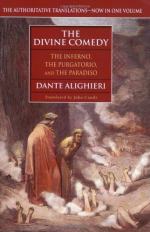|
This section contains 6,279 words (approx. 21 pages at 300 words per page) |

|
SOURCE: Mills Chiarenza, Marguerite. “The Imageless Vision and Dante's Paradiso. In Dante, edited by Harold Bloom, pp. 83-95. New York: Chelsea House, 1986.
In the following essay, originally published in 1972, Mills Chiarenza explains how Dante's exquisite poetic imagery mysteriously leads the reader to an imageless vision of spiritual realms.
In interpreting St. Paul's claim to have been rapt to the third heaven, St. Augustine developed a theory of knowledge which influenced the entire Middle Ages. For St. Augustine the problem was to define the third heaven and this involved discovering what was meant by the other two as well. He concluded that the three heavens are to be taken in a spiritual sense and represent three modes of vision. Briefly, the first mode is visio corporalis, knowledge through the senses of material objects; the second, visio spiritualis, is knowledge through the imagination in which, as in dreams, the senses...
|
This section contains 6,279 words (approx. 21 pages at 300 words per page) |

|


